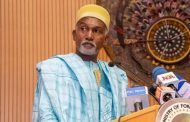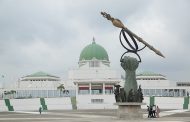Before the mediascape was overtaken by the frustrating details from South Africa, this platform was breaking down the September 22nd, 2019 Inaugural Lecture basically on Federalism by Professor Eghosa Osaghae of the University of Ibadan. It started with Contextualizing, Unpacking and Performing Federalism in Eghosa Osaghae’s 2019 Inaugural Lecture. Intervention is devoting so much time to that and other Inaugural Lectures before this because, if Nigeria were at peace with itself, a Prof Osaghae speaking on Federalism is the type of voice it would be all ears. This has nothing to do with his being a Professor or a brilliant mind but everything to do with his membership of that special cadre of Nigerian intellectuals whose testimonies, arguments and analysis have performative implications. Performative is the right word to use because what they say have consequences for action or policy, if you like.
In other words, there is a certain level of scholarship the typical scholar attains that makes him or her compulsive articulator of the state if such a state is to avoid the Hobbesian ‘state of nature’ by which Thomas Hobbes meant war of all against all arising not from unrestrained aggressive instincts but from inter-discursive rupture. This is why the recruitment of such category of intellectual stock into the theory and practice of state power becomes a minimum requirement for nation building in most organised societies. They are not called intellectuals of statecraft in those climes for nothing.

Is the Nigerian State tapping anything systematically from a Prof Agbaje?

Is this state tapping from a Prof Ibrahim?
That Nigeria has nothing systematic in that direction is beyond argument, making it part of the trouble with Nigeria. It is the absence of a systematic programme of recruitment of such people into the spaces of model building, development strategies, scenario simulations and grand strategies for National survival that one finds a Prof Okey Ibeanu or a Prof Sam Egwu at INEC, for instance or a Prof Jibrin Ibrahim writing weekly columns something of an absurdity! These are some of the members of the top 10 in the case of Political Science, with counterparts in all other disciplines such as Economics, Psychology, Engineering, History, Sociology, Geography, Linguistics, Medicine, Literature and so on. Yet, Nigeria is dreaming to be a member of the top 20 economies sometimes in future. How can it happen?
As politicians have no time or the capacity for the level of abstraction needed for every nation to reproduce itself in a highly competitive world, correcting the famished presence of intellectuals of statecraft in the system must be part of the struggle for substantive democracy in Nigeria.
That is by the way. At stake now is what Osaghae had to say on federalism on the occasion, federalism being in the surgery room in Nigeria today. It is important for all those reading this to recall one of the three points of departures he started the lecture with and which is that he travels in the scientific caravan of knowledge production, premised on the assumption that no one ever has that amount of information to say that his own narrative is the truth at any particular point. Truth is never completely known. He was thus proceeding not by proving what is true but rather by eliminating what is false, (reference supplied).
On this occasion, Osaghae came to the podium with a question, a puzzle for us all. But he first provides a background to that and which is this: although, there is every reason to vote for federalism in Africa where polycentric states or compound republics have been problematic for inclusivity and ownership, the problem is that federalism and federal solutions especially of the federal government variety have not always worked well or not been successful whether as means to ends or as ends in themselves. He goes on to cite how there are as many, if not more, failed, failing and troubled federal systems and solutions as there are successful ones, with Yugoslavia and the former USSR providing some of the more recent examples. And to show too how Nigeria had been the only (stressfully) successful federal system in Africa as all other federal arrangements collapsed, from Rhodesia/Nyasaland, Uganda, Cameroon, Kenya down to Sudan. The other exception is Tanzania. Otherwise, no success story for federalism beyond Nigeria until the resurgence of federalism in South Africa, Comoros, and Somalia, all of which are recent.

Prof Eghosa Osaghae: problematising federalism
His question then is what might explain why a system considered so rational and adopted for its acclaimed accommodative, curative and prosperity- enhancing qualities flounder so badly? Then he changed his mind and recast the question: why does federalism work relatively well in some countries and not in others? The reframing is so that he doesn’t ignore the success stories of federalism across the world. He makes the question more specific: why is the clamour for restructuring more endemic and recurrent in some federal systems (like Nigeria’s)?
To answer this question, he takes a tour of the different explanations on why federalism fails here and there. One of such arguments is the thesis of delicate and unpredictable nature of the federal bargain. Another is what has become known as Mill’s “law” of federal instability which makes the point that a federal system cannot last long if one or a few component units dominate the others. There is also the argument that absence of democracy and constitutionalism could lead to federalism atrophying because “federalism and democracy are, almost by definition, one solidary, recursive couple”.
As much as he concedes that each one and combinations of these explanations provide powerful insights, he does not think they sufficiently address the question of why federalism works well in some situations but not in others. The empirical evidence as far as he sees it point to a rather a different explanation. According to Osaghae, the reason lies in the extent to which politics perpetually overrides or overwhelms all other considerations in the federal bargain. Anchoring on an earlier article by an older Ibadan Political Scientist, Prof Essien-Udom, Osaghae’s point of departure is that ‘politics without vision’ is where the trouble lies. “Nigerian federalism and state floundered because, for the elite, politics whose high point is state capture, takes precedence over compelling social and economic considerations that are capable of expanding the common good and reinforcing the basis of union, as is the case in many other federal systems”, he asserts, pursuing that line in another sentence that must be quoted: In the sitting of projects like refineries and strategic military units, to take one example, rational considerations of feasibility and optimal utility are sacrificed for unproductive political considerations in a manner that suggests that the purpose of belonging to the state is extractive and not productive, even when it is obvious that the country cannot survive for long with such predatory and self-serving practices”. Borrowing another scholar’s terminologies, he says the underlying ‘politics without vision’ provides the framework for analysing the fragility of the federal government in emergent federations like Nigeria in contrast to mature federations like the USA.
Osaghae’s explanatory model of a visionless elite is complicated by another tension in postcolonial societies. Unlike in where federalism has been more successful, the identities, interests and statuses of constituent units and groups, the owners if you like, of a federal system in the societies where it has been less successful were not as a basis, precondition or foundation for federalism. Prof Osaghae’s explanation of this goes as follows: While the constituent identities, groups and statuses in those considered mature federations are largely consolidated, that is not the case in emerging federations where they were and remain contested and unresolved. The coming together of incomplete process of solidifying constituent units and the process of federalizing or trying to build a federal system at the same time as the ethnic groups and other constituent units, is at the heart of the fragility of federalism in countries like Nigeria. That is holding the contradictory pulls of the efforts to build constituent groups and the federal system simultaneously responsible for the crisis of federalism because the twinning complicates and intensifies the problem(s) federalism is adopted to address in the first case. There is a sort of a clincher at this point to the effect that analyses that have interrogated the nexuses between federalism and the political mobilization of ethnicity, regionalism, communalism, and cultural and religious pluralism have hinted at this but none has so far identified the disenabling propensities of the flawed foundations. That is to say that scholars ranging from Billy Dudley; Rotimi Suberu; Adele Jinadu; Isawa Elaigwu and Olorunsola; John Ayoade; Peter Ekeh and Osaghae himself didn’t see the problem from this angle.
So, he feels comfortable in arguing that federalism is more likely to thrive and function well and be relatively stable when the groups or units desiring the purposive union and their interests were already consolidated. Where this is not the case, then federalism is less likely to function well, be stable or even survive. He uses the federation of the USA which emerged from the bargains involving the original thirteen colonies as best exemplifying this notion that federal systems that emerge from the aggregative process in which the identities, territories, autonomy and interests of the constituent units have fully crystallized are more likely to survive and be less stressed by demands for restructuring than those in which the constituent units are like the federal system in the process of being fully formed. In the case of the US, the colonies were well-formed and enjoyed substantial autonomy in a way that made bargain relatively easier. And he stretches this to Switzerland, Germany and Canada which a scholar of federalism has listed in the category of mature federations in contrast to disaggregative federations which generally present the opposite scenario, including “major differences between say Ethiopia, Tanzania and Comoros where the constituent ethnic nationalities and units were properly formed and consolidated before federal union, and Nigeria, India and indeed many multiethnic states in sub-Saharan Africa where the component units (ethnic groups, regions, provinces, etc.) were not and remain at different stages of incomplete and contested formation”.

Columbia University’s Prof Mahmoud Mandani warned Ethiopia last January against ethnic federalism before the June coup attempt.
 “The basis of all this, which is not generally known, is that many of the ethnic groups and political categories that exist today, the names they bear as well as the territories they claim, the languages they speak and the loyalties now directed at them, took roots and were constructed within the states that emerged from the colonial process and are therefore as new, if not as artificial, as the states to which they belong”. To this he adds how, in much of Africa, “What happened was that the colonial regimes administratively created tribes as we think of them today”. Relying on evidence from a different scholar, he cites the example of the Baluhyia of western Kenya which emerged between 1935 and 1945 as a ‘tribe’ in the form of a colonial administrative unit. Kasfir and also the Baganda and Luo as two of the ‘new’ ethnic groups that emerged in Uganda. This applies even more to Nigeria where yet another authority has been quoted as saying that “what existed before Nigeria were amorphous polities”, connecting this to how Thomas Hodgkin “debunked (Prof Saburi) Biobaku’s claim to the existence of an organic Yoruba group by asserting that “Everyone recognizes that the notion of ‘being a Nigerian’ is a new kind of conception. But it would seem that the notion of ‘being a Yoruba is not very much older”.
“The basis of all this, which is not generally known, is that many of the ethnic groups and political categories that exist today, the names they bear as well as the territories they claim, the languages they speak and the loyalties now directed at them, took roots and were constructed within the states that emerged from the colonial process and are therefore as new, if not as artificial, as the states to which they belong”. To this he adds how, in much of Africa, “What happened was that the colonial regimes administratively created tribes as we think of them today”. Relying on evidence from a different scholar, he cites the example of the Baluhyia of western Kenya which emerged between 1935 and 1945 as a ‘tribe’ in the form of a colonial administrative unit. Kasfir and also the Baganda and Luo as two of the ‘new’ ethnic groups that emerged in Uganda. This applies even more to Nigeria where yet another authority has been quoted as saying that “what existed before Nigeria were amorphous polities”, connecting this to how Thomas Hodgkin “debunked (Prof Saburi) Biobaku’s claim to the existence of an organic Yoruba group by asserting that “Everyone recognizes that the notion of ‘being a Nigerian’ is a new kind of conception. But it would seem that the notion of ‘being a Yoruba is not very much older”.
The same could, in his view, be said for ‘being’ Edo, Igbo, Tiv, and so on, pointing at what Prof Justin Tseayo said in the case of the Tiv in a work he published in 1975 on the Tiv. The testimony is that Yoruba, for instance, used to be a name which specifically referred to people from Oyo-Ile and to distinguish them from other groups like the Ijebu, Egba, Ijesha, Ekiti, and Awori and its transmutation owed a lot to the Church Missionary Society leaders who in the 19th century popularized the name Yoruba to refer to groups in the present southwest of the country. Osaghae recognises that this is one account while referencing some other accounts which trace the origins of the name to Hausa usage. Things were such that the colonial administrators, particularly Governor Hugh Clifford dismissed the claims of consolidated ethnic groups and insisted “on the right, for example, of the people of Egbaland rather than Yoruba…of any of the Emirates of the North rather than Hausa-Fulani)…to maintain that each one of them is, in a very real sense…a nation”.
What has happened, by Osaghae’s authority is that “the process of putting the groups together into their present forms, that is, the process of raising communal consciousness of individual members and tightening collective bonds (reference removed) that transformed the (objective) “ethnic group-in-itself” to the “ethnic group-for-itself”, took the interventions and mobilizations—or nationalisms—of elites described as ethnic ‘brokers’, ‘entrepreneurs’, and ‘champions’ to build new ethnic identities, groups, and empires”. This is his inference from what others such as Richard Sklar; Archie; Mafeje and Okwudiba Nnoli have said in their different work. And he cites the role of the Egbe Omo Oduduwa in the emergence of the modern-day Yoruba group as one of the best-studied examples of this process.
His narrative goes as follows: The Egbe was formed in 1945 in London to promote the culture and unity of the Yoruba and to ensure a secure future for them within the evolving Nigerian state, along the lines of the Ibibio State Union and Ibo State Union which emerged earlier to do similar things for the Ibibio and Igbo groups-in-view. By the time the group transformed into a political party, Action Group, in 1950/51 to enable the Yoruba to take their rightful place in the evolving state, the politicization of the process which involved the emergence of Yoruba as a unit for exacting political claims and rights including the right to self-determination was complete. This was the trajectory most ethnic constructions went through. The building blocks of the ethnicization process, which the new men of power exploited to the fullest were invented charter myths of common origin, cultural maps drawn by (colonial) anthropologists, standardized native languages initially developed by missionaries to facilitate proselytization and later by linguists, and administrative units created by colonial administrations”.

The first generation of philosophers and practitioners of federalism in Nigeria -Awo, Zik, Balewa and Ahmadu Bello

Except IBB & Abacha, here is the successor generation of military federalism but who, for most of the time, acted out Marx’s idea of capitalists ‘as a band of hostile brothers’, with serious implications for others
Taking the Fulani who, in his words, bestride the majority-minority divide as presenting a fairly peculiar case of a dominant minority, Osaghae captures it as the elite which built its power base on the majority Hausa whose language and its historical pre-eminence in the Islamic religion it adopted. Although the two groups are distinguishable and Hausa elites have risen to challenge Fulani overlordship, they have become fused as a political majority.
In summary, Osaghae endorses Prof Peter Ekeh’s argument about the reality-creating functions of domain-partition ideologies and myths such that “the corporate character now attributed to the various ethnic groups is the reality that flowed from the ideologies and myths invented by the bourgeoisie to consolidate their parcels of influence”. This is another way of saying how the ethnic majorities and minorities which are the major political cleavages in Nigerian politics emerged. So recently constructed that several decades in that journey in ethnic constructivism, the boundaries and identities remain uncompleted, contested, and in a state of flux. Hence, the reality of intra-group and intergroup contestations erupting over “tribalizations” of identity, language, authenticity, superiority, leadership, traditional authority, or even name every now and then, here and there. This is also why new ethnic groups and forms of ethnicity including militant youth retribalizations, ethnic shadow states and ‘migrant ethnic empires’ organized around diaspora traditional ‘rulers’ in major urban centres in Nigeria and abroad are constantly changing the ethnic complexion. This newness, open-ended constructions and reconstructions, and the conflicting criteria for identifying groups largely explain why the actual numbers of ethnic groups in Nigeria remain unknown and indeterminate. Initial estimates put the number at 248, then 350, then over 500! For Osaghae, the question is how might an ethnic federation be possible when the ethnic groups or categories are not known?
By way of conclusion, Osaghae asserts that the critical point from the foregoing is not so much the newness of ethnic groups and ethnic identities as man-made entities but the fact that they were constructed and mobilized within the evolving new state structures. The implication is that the ethnic ‘constituent units’ whose leaders took part in the federal bargain were neither organic nor autonomous as federal theory expects them to be. They were rather “products of the evolving federal system whose greater interest was the pursuit of partisan and exclusionary good which promised greater cohesiveness of the group-in-making rather than the common good”. That makes the administrative and political units (local governments, regions, states, geopolitical zones) that serve(d) as legal-constitutional ‘federating units’ were not different but ‘artificial’ creations of colonial and post-independence governments, he adds.
Is there a problem with having consolidated constituent units, especially ethnic units, as building blocks? This is a tough question considering the view by some scholars of federalism that federalism becomes inevitable if the major identifying diversities within a state are arranged territorially and that the society is not a candidate for federalism where the distribution of diversities is a salad bowl or scattered. His analysis is that when we consider the high number of ethnic groups in the country—well over 300 and the dispersed or marble-cake pattern of ethnic territories, ethnic federation is not feasible. Having ethnic units would be more dangerous, he says, because they are more enabling of asymmetries and exclusionary, separatist and secessionist tendencies, as the Igbo-based Biafra struggles and periodic agitations for confederal arrangements by aggrieved majority ethnic groups in Nigeria would suggest. Looking farther into the experiences of ethnic federalism in Ethiopia and resource control agitations in Nigeria, Cameroon, and Uganda, he can see similar tendencies but he still thinks it is a matter for debate whether such objections are strong enough grounds to reject the centrality of consolidated constituent units and interests in a federal system. Although he doesn’t think the units need to be ethnic, he insists the parties to the federal bargain and the interests to be bargained—“the real owners”—have to be defined the way the framers of the Ethiopian constitution recognized the need for such clear definition in an ethnic federation.

 His list of the federating units and constituents in the case of Nigeria are a legion: states, regions, geopolitical zones, ethnic groups, religious groups, traditional authorities, and the various groups and associations that claim to represent the diversity of ethnic, cultural, and geopolitical interests (Arewa Consultative Forum, Northern Elders Forum, Afenifere, O’dua People’s Congress, Ohaneze Ndigbo, MASSOB, IPOB, Ijaw National Congress, PANDEV, South-South Peoples’ Assembly, Middle Belt Congress, Christian Association of Nigeria, Supreme Council for Islamic Affairs, and so on). Unlike in the USA where there have been only 33 amendments since the constitution was adopted in 1789, Nigeria has had several constitutions (1960, 1963, 1979, 1989, 1999), several constitutional, national and political conferences, and has been restructured into more states and local government areas since a federal constitution was adopted in 1954. And yet, the federal solution remains endlessly stressed and precarious with demands for political restructuring, true federalism and confederalism because the “real owners” of the federation has not been fully resolved, leaving the union incapable of asserting “a principle by which to live – and for which to die”, and is left to “survive … by any means possible” as the scholar Mansfield put it. It is another way of validating his thesis that federalism works better where constituent units and interests were consolidated prior to its emergence.
His list of the federating units and constituents in the case of Nigeria are a legion: states, regions, geopolitical zones, ethnic groups, religious groups, traditional authorities, and the various groups and associations that claim to represent the diversity of ethnic, cultural, and geopolitical interests (Arewa Consultative Forum, Northern Elders Forum, Afenifere, O’dua People’s Congress, Ohaneze Ndigbo, MASSOB, IPOB, Ijaw National Congress, PANDEV, South-South Peoples’ Assembly, Middle Belt Congress, Christian Association of Nigeria, Supreme Council for Islamic Affairs, and so on). Unlike in the USA where there have been only 33 amendments since the constitution was adopted in 1789, Nigeria has had several constitutions (1960, 1963, 1979, 1989, 1999), several constitutional, national and political conferences, and has been restructured into more states and local government areas since a federal constitution was adopted in 1954. And yet, the federal solution remains endlessly stressed and precarious with demands for political restructuring, true federalism and confederalism because the “real owners” of the federation has not been fully resolved, leaving the union incapable of asserting “a principle by which to live – and for which to die”, and is left to “survive … by any means possible” as the scholar Mansfield put it. It is another way of validating his thesis that federalism works better where constituent units and interests were consolidated prior to its emergence.
He is though not suggesting that federalism has failed in Nigeria but only why the system has not worked as well as it ought to have, being, in his view, such a widely accepted and perhaps the most effective rational responses to the problems and challenges of diversity when compared to other such options. In all cases, he argues that federalism is not a system of government but a solution, a more encompassing and context-discerning device and, therefore, a dependent variable that goes beyond the legal-constitutional formats. He insists that emergent traditions in Africa and Asia belong to the notion of federalism as a solution to management of diversity and complexity in contrast to the Anglo-Saxon and European traditions which are more legal-constitutional and economic integration inclined. This is why although Nigerian leaders who opted for the federal solution in 1954 did so with the model of federalism in Australia, especially the element of guaranteed regional autonomy, Nigeria’s federalism is today vastly different from Australia’s, an outcome Osaghae locates in how Nigerian leaders worked out a federal pact that suited the country’s circumstances. In other words, federalism is not adopted in a once-and-for-all manner. The elites who work out the original pact, the groups they represent, the interests and desires that drive the federal pact as well as the domestic and external strategic, economic, social and political circumstances do not remain the same. As they change, the federal arrangement faces new challenges that often require the adoption — through bargain — of new instrumentalities.
Applying this to Nigeria, Osaghae establishes the link in his own words as follows: This is what makes restructuring, which has become a recurrent theme in Nigerian federalism, integral to federalism. It suggests the need for one kind of rectificatory rejigging or the other of federal instrumentalities to make the system better able to solve the problems that necessitated its adoption in the first place. In its multidimensional complex, restructuring has proponents and opponents in fairly good measure, which accords well with the true character of federalism as a system of bargains among rational actors who seek to minimize losses and maximize gains. In this wise, restructuring is common to all federal systems which are challenged by changing political, social and economic circumstances and demands to adapt and change form to make the system work and not collapse, but the form restructuring takes, its intensity and manageability, as well as successes and failures, differs from one federal system to another, and within a federal system, from time to time. But while it is true that restructuring is necessarily a concomitant of federalism, intense and endless demands for restructuring especially those that threaten the stability or survival of the system suggest that all is not well with the system.
This is where the creative federalism that he elaborated upon at another Inaugural Lecture at the University of London entitled “A State of our Own” in 2014 becomes attractive for the circumstances of states in Africa and Asia whose colonial origins and interventions have compounded crises of ownership and legitimacy. Osaghae has thus provided a jump off point for all conflict parties in managing diversity in Nigeria, from liberals to radicals of all hues, revolutionaries of all hues and even anarchists.




























